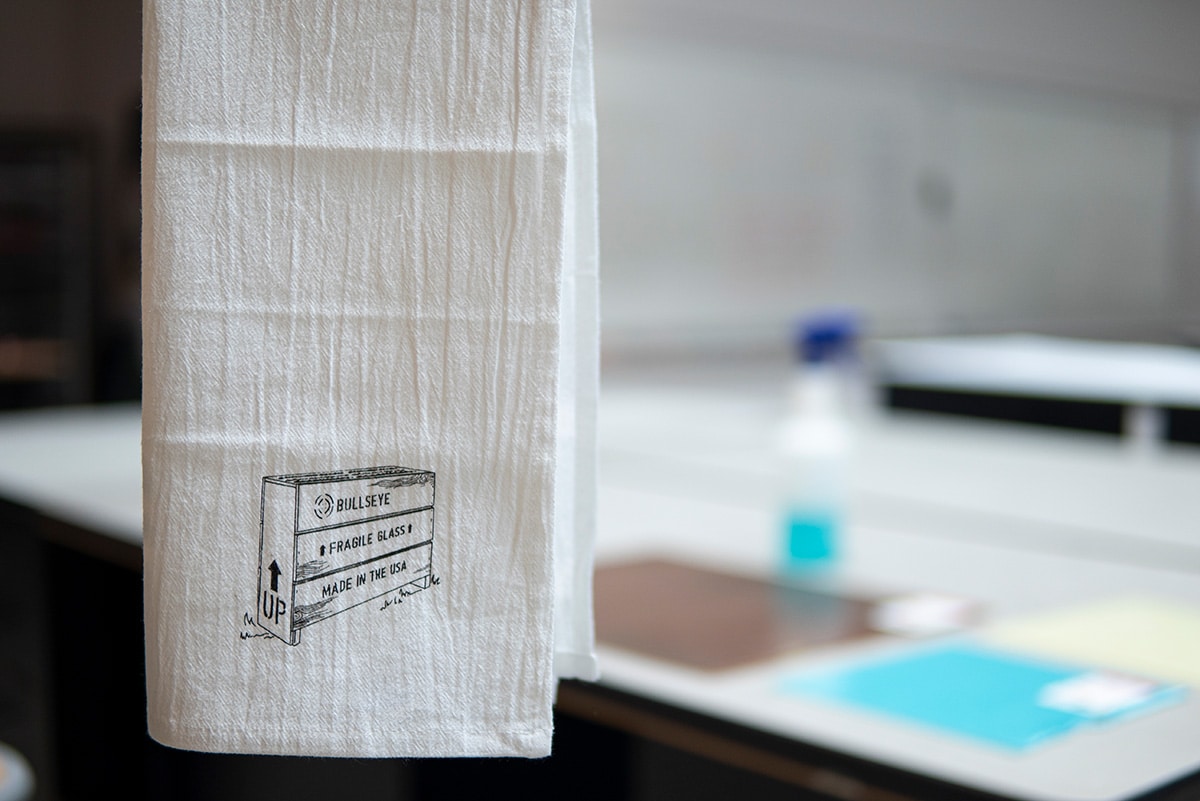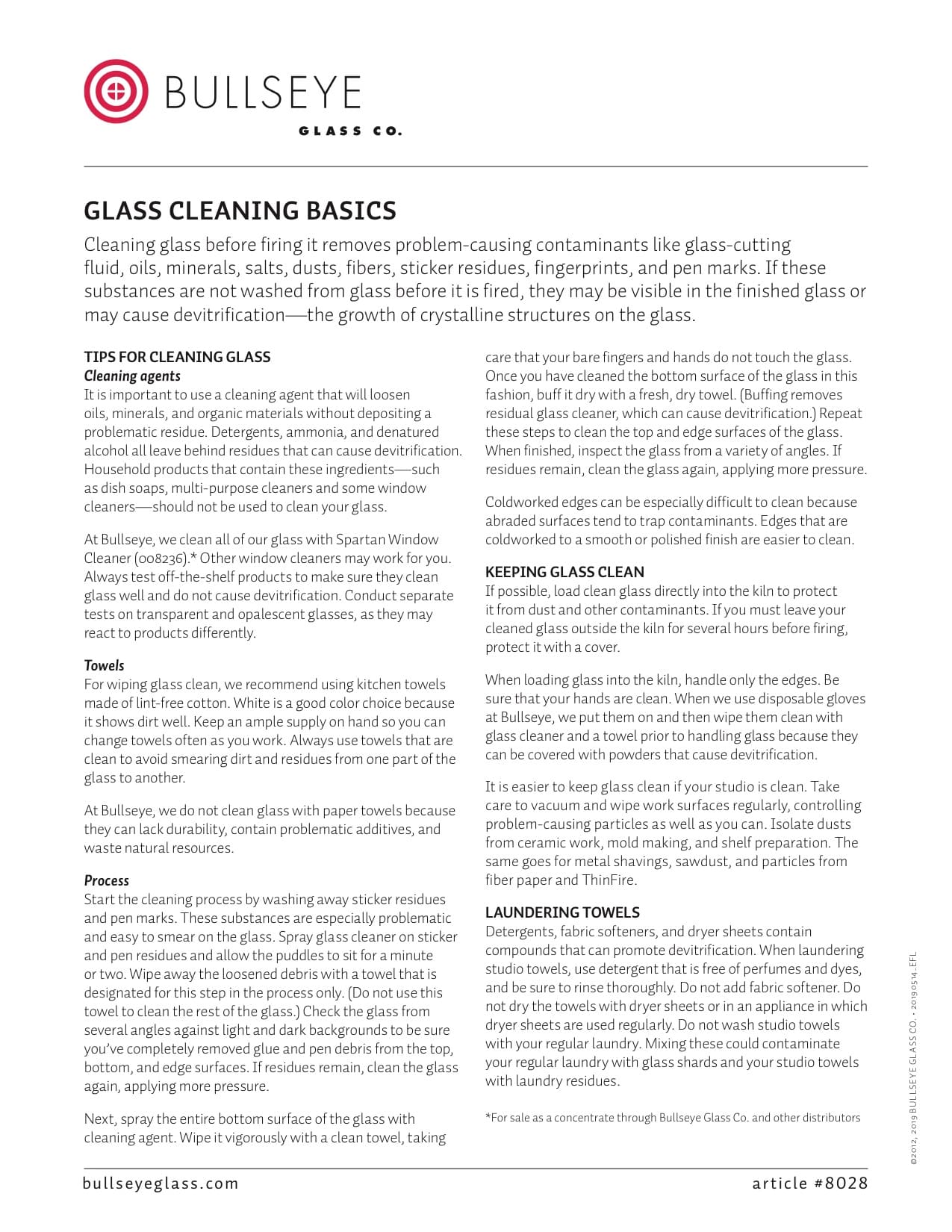Simple & Essential
Cleaning glass before firing it removes problem causing contaminants like glass-cutting fluid, oils, minerals, salts, dusts, fibers, sticker residues, fingerprints, and pen marks. If these substances are not washed from glass before it is fired, they may be visible in the finished glass or may cause devitrification—the growth of crystalline structures on the glass.
Tips for Cleaning
Glass Cleaning Agents
It is important to use a cleaning agent that will loosen oils, minerals and organic materials, without depositing a problematic residue. Detergents, ammonia and denatured alcohol all leave behind residues that can cause devitrification. Household products that contain these ingredients—such as dish soaps, multi-purpose cleaners and some window cleaners—should not be used to clean your glass.
At Bullseye, we clean all of our glass with Spartan Window Cleaner.* Other window cleaners may work for you. Always test off-the-shelf products to make sure they clean glass well and do not cause devitrification. Conduct separate tests on transparent and opalescent glasses, which may react to products differently.
Towels
For wiping glass clean, we recommend using kitchen towels made of lint-free cotton. White is a good color choice because it shows dirt well. Keep a good supply on hand so you can change towels often as you work. Always use towels that are clean, to avoid smearing dirt and residues from one part of the glass to another.
At Bullseye, we do not clean glass with paper towels because they can lack durability, contain problematic additives and waste natural resources.
Process
Start the cleaning process by washing away sticker residues and pen marks. These substances are especially problematic and easy to smear on the glass. Spray glass cleaner on sticker and pen residues and allow the puddles to sit for a minute or two. Wipe away the loosened debris with a towel that is designated for this step in the process only. (Do not use this towel to clean the rest of the glass.) Check the glass from several angles against light and dark backgrounds to be sure you’ve completely removed glue and pen debris from the top, bottom, and edge surfaces. If residues remain, clean the glass again, applying more pressure.
Next, spray the entire bottom surface of the glass with cleaning agent. Wipe it vigorously with a clean towel, taking care that your bare fingers and hands do not touch the glass. Once you have cleaned the bottom surface of the glass in this fashion, buff it dry with a fresh, dry towel. (Buffing removes residual glass cleaner, which can cause devitrification.) Repeat these steps to clean the top and edge surfaces of the glass. When finished, inspect the glass from a variety of angles. If residues remain, clean the glass again, applying more pressure.
Coldworked edges can be especially difficult to clean because abraded surfaces tend to trap contaminants. Edges that are coldworked to a smooth or polished finish are easier to clean.
Keeping Glass Clean
If possible, load clean glass directly into the kiln to protect it from dust and other contaminants. If you must leave your cleaned glass outside the kiln for several hours before firing, protect it with a cover.
When loading glass into the kiln, handle only the edges. Be sure that your hands are clean. At Bullseye, we do not use disposable gloves when handling glass because they can be covered with powders that cause devitrification.
It is easier to keep glass clean if your studio is clean. Take care to vacuum and wipe work surfaces regularly, and control problem-causing particles as well as you can. Isolate dusts from ceramic work, mold making and shelf preparation, as well as metal shavings, sawdust, and fiber-paper and ThinFire particles.
Laundering Towels
Detergents, fabric softeners, and dryer sheets contain compounds that can promote devitrification. When laundering studio towels, use detergent that is free of perfumes and dyes, and be sure to rinse thoroughly. Do not add fabric softener. Do not dry the towels with dryer sheets or in an appliance in which dryer sheets are used regularly. Do not wash studio towels with your regular laundry. Mixing these could contaminate your regular laundry with glass shards and your studio towels with laundry residues.
To learn more, download and print the free pdf article, also available for your convenience as part of Bullseye’s TechBook.


